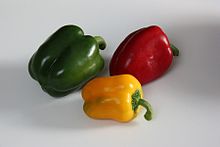
Bell peppers

The bell pepper (also known as sweet pepper, pepper or capsicum /ˈkæpsɪkəm/) is a cultivar group of the species Capsicum annuum. Cultivars of the plant produce fruits in different colours, including red, yellow, orange, green, white, and purple. Bell peppers are sometimes grouped with less pungent pepper varieties as 'sweet peppers'. Peppers are native to Mexico, Central America, and northern South America. Pepper seeds were imported to Spain in 1493 and then spread through Europe and Asia. The mild bell pepper cultivar was developed in the 1920s, in Szeged, Hungary. Preferred growing conditions for bell peppers include warm, moist soil in a temperature range of 21 to 29 °C (70 to 84 °F). The name 'pepper' was given by Europeans when Christopher Columbus brought the plant back to Europe. At that time, black pepper (peppercorns), from the unrelated plant Piper nigrum originating from India, was a highly prized condiment. The name 'pepper' was at that time applied in Europe to all known spices with a hot and pungent taste and was therefore naturally extended to genus Capsicum when it was introduced from the Americas. The most commonly used alternative name of the plant family, 'chile', is of Mexican origin, from the Nahuatl word chilli. The terms 'bell pepper' (US, Canada), 'pepper' or 'sweet pepper' (UK, Ireland, Malaysia), and 'capsicum' (Australia, India, New Zealand and Pakistan) are often used for any of the large bell-shaped peppers, regardless of their color. The vegetable is simply referred to as a 'pepper', or additionally by color ('green pepper' or red, yellow, orange, purple, brown, black). In the Midland region of the U.S., bell peppers when stuffed and pickled are sometimes called 'mangoes.' In some languages, the term 'paprika', which has its roots in the word for pepper, is used for both the spice and the fruit – sometimes referred to by their colour (e.g., 'groene paprika', 'gele paprika', in Dutch, which are green and yellow, respectively). The bell pepper is called 'パプリカ' (papurika) or 'ピーマン' (piiman, from Portuguese pimentão) in Japan. In Switzerland, the fruit is mostly called 'peperone', which is the Italian name of the fruit. In France, it is called 'poivron', with the same root as 'poivre' (meaning 'pepper') or 'piment'. In Spain it is called 'pimiento', the masculine form of the traditional spice, 'pimienta'. In South Korea, the word '피망' (pimang from the Japanese 'ピーマン' (piiman)) refers to green bell peppers, whereas '파프리카' (papeurika from paprika) refers to bell peppers of other colors. In Sri Lanka it is called 'maalu miris' when used as a vegetable. The most common colors of bell peppers are green, yellow, orange and red. More rarely, brown, white, lavender, and dark purple peppers can be seen, depending on the variety. Most typically, unripe fruits are green or, less commonly, pale yellow or purple. Red bell peppers are simply ripened green peppers, although the Permagreen variety maintains its green color even when fully ripe. As such, mixed colored peppers also exist during parts of the ripening process. Like the tomato, bell peppers are botanical fruits but culinary vegetables. Pieces of bell pepper are commonly used in garden salads and as toppings on pizza or cheesesteaks. There are many varieties of stuffed peppers prepared using hollowed or halved bell peppers. Bell peppers (and other cultivars of Capsicum annuum) may be used in the production of the spice paprika.
